I couldn’t believe when he gave me the machine…..8 years ago. I had wanted to make my own pasta forever and getting one of the silver, rolling thingies was top of my list in Nigeria, in 2003. So when a friend moving abroad offered me his brand new, unused machine, I snapped it up!
Which is why I wonder why it took me 96 whole months…till 2011 and almost counting to get my behind in line and actually roll out some sheets of pasta dough. All thanks to the Daring cooks.
Blog-checking lines: Steph from Stephfood was our Daring Cooks’ July hostess. Steph challenged us to make homemade noodles without the help of a motorized pasta machine. (Hand cranking machines were allowed but nothing with a running motor or requiring electricity)
Mandatory Items: Prepare some pasta by hand, without the use of motorized tools, and prepare the appropriate sauce/seasoning to go with it. The concept of “noodle” or “pasta” is being applied very loosely here, as some traditional recipes may seem closer to a dumpling than what you consider a noodle. Use your own judgment and creativity here.
Variations allowed: Many variations are allowed here – no strict recipe is required. It goes without saying that people with dietary requirements may substitute the “traditional” ingredients in favor of ingredients that are appropriate for them. Similarly, substitutions may be made where suggested ingredients are not readily available, or are cost prohibitive.
First of all, if you’ve never made your own pasta dough and are gifted with a machine – relax and be of good courage, for you will feel as though you have overcome the world on your first attempt. Especially if ALL three of your children gobble up the tagliatelle you make.
And then demand to make their own pasta – one daughter made a sheet of pasta, with tassles at each end – reminded me the fringles/tassles on cowboy boots and she ate it too, topped with some pasta sauce!
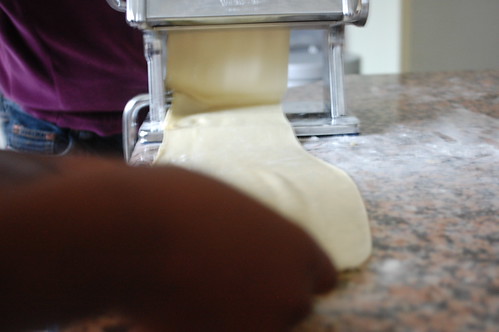
The other daughter and son made ‘noodles’ or ‘moodles’ according to the 4-year old chap (whose birthday it is today). I par-boiled them and then made a stir-fry with onions and chicken and a touch of light soy – ALL three of them gobbled this small bowl up. And my husband and I experimented with tortellinis, stuffed with cheese curd and served with sage butter, the pasta was good – the filling not…but for me this challenge was all about learning to make pasta.

What I enjoyed the most was watching the dough transforms from simple mixture, to this hyper-strong sheet – I watched ‘real’ pasta take shape before my very eyes – awesome! At the end of the day when I was done, my sense of accomplishment knew no bounds. And I have convinced myself once again that there is time for everything and for me – this was the absolutely perfect time to make my own pasta.
Basic Pasta Dough Recipe
Ingredients
200g Tipo ‘00’ flour2 large free-range organic eggs (or 4 yolks) 1 tablespoon olive oil
I used Tipo ‘00’ flour – a very finely sieved flour, normally used for making egg pasta or cakes. In Italy, it’s called farina di grano tenero, which means ‘tender’ or ‘soft’ flour.
Making the pasta dough
Place the flour on a board or in a bowl. Make a well in the centre and crack the eggs into it. Beat the eggs with a fork until smooth. Using the tips of your fingers, mix the eggs with the flour, incorporating a little at a time, until everything is combined. I found it too tough to mix right away into a cohesive lump of dough, so I let it rest a few minutes and then came back to knead – the result? One smooth ball of sunny yellow dough.
You can also make your dough in a food processor if you’ve got one. Just bung everything in, whiz until the flour looks like breadcrumbs, then tip the mixture on to your work surface and bring the dough together into one lump, using your hands. Yotam Ottolenghi makes great looking ravioli using the food processor method.
Once you’ve made your dough you need to knead and work it with your hands to activate the gluten in the flour so you end up with chewy, springy dough when you cook it, not soft and tender! And unlike some bread recipes, there are no formulas to working the dough. The desired result is a smooth, ‘together’ ball – how you get there is your choice!
When the dough is ready – it should be without traces of flour or bumps. Mine may not be the ‘epitome’ of perfection but this was the smoothest I could get it!
Wrap it well in cling film and refrigerate, letting it rest for at least half an hour before you use it.
Rolling out your pasta dough
Though pasta can be made by hand, the directions I give below are for using a rolling machine.
Clean a large space on your worktop, if available and then secure the machine by clamping it down firmly before you start.
Sprinkle some Tipo ‘00’ flour onto your worktop and remove half of the pasta dough, leaving the rest covered in the fridge.
Press out the lump of dough and press it out flat between your palms. Set the pasta machine to its widest setting (my widest setting is 1 and the narrowest, 9). Pass the pressed pasta dough through it. If it sticks, lightly dust the pasta with flour.
The next step is working the dough to activate the gluten (proteins in the mix). Though it may look like many steps, they only take a short time and really transform the texture of the dough. And if like me, this is your first time using your pasta machine, you’ll be in awe and want to stick at it…..
So, click the machine down to the next setting and roll the dough out again.
Fold the pasta in half, click the pasta machine back up to the widest setting and roll the dough through again. Repeat this process five or six times. Once you’re done, you’ll find out the dough has transformed….. It’ll be smooth as silk, unbelievably so – it should remind you of lasagna sheets.
Rolling the dough ‘proper’
Now it’s time to roll the dough out properly, working it through all the settings on the machine, from ‘1 to 9′ – widest to narrowest. Lightly dust both sides of the pasta with a little flour (on the earlier floured work surface – makes life easy) every time you run it through. As you work the pasta dough, you’ll see the colour whiten and lighten – i suspect both from the working and mixing of the dough and the added flour…..
When I got down to the narrowest setting, I cut my pasta sheet in half, set one half on the counter, covered and worked the other half. Rolling it one last time before passing it through the tagliatelle cutter. Once that was done, I set up a drying rack by making a bridge with a rolling pin set on two stools. Then I hung the pasta out to ‘dry’.
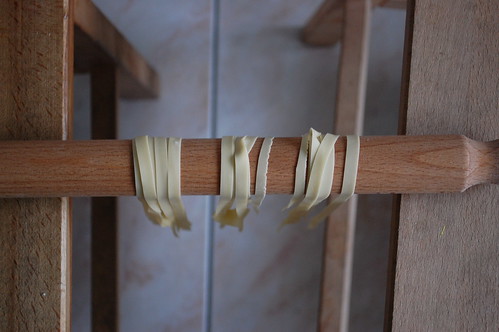
For the tortellinis, I rolled out the other half of the pasta which I’d kept covered and cut the strip into ‘squares’, on which I placed dollops of a cheese curds, mixed with grated pecorino, bound together with some whisked egg, salt and pepper.
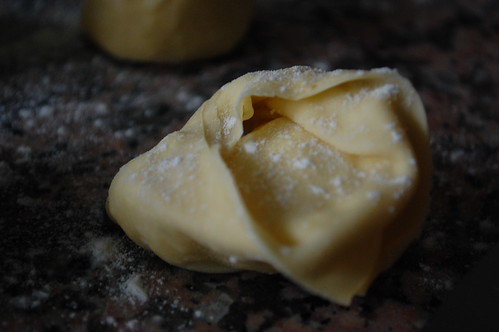
It is important to cut/shape the pasta once it is ready so it doesn’t dry out. Alternatively, cover with a damp (clean) tea towel to stop it from drying.
Cook in boiling salted water. And serve as you wish.
It was interesting because I managed with relative ease to roll out the pasta by myself. I know a lot of people think having help when rolling it out is essential but I think the key is having a clear work top and working small portions of dough at a time. But it may just be me….because I love cooking by myself!
The Verdict
The pasta was DELICIOUS. We enjoyed the tagliatelle and noodles the best – the tortellinis were nice but I didn’t like the filling (I made), which wasn’t exactly what I planned, missing lemon zest (I was not able to go out to buy some!)
My son gobbled up his with pasta sauce as did one daughter.
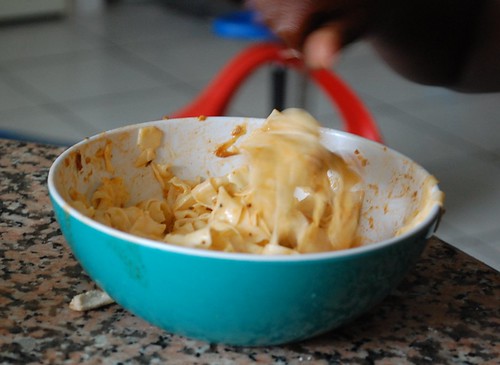
The other daughter had hers with olives and basil on a tortilla.
The interesting thing was the change in colour once cooked, from light yellow mixture to almost white when cooked. Now I understand perhaps why some recipes lean towards using only egg yolks, as the finished result ends up looking like the light yellow pasta we’re familiar with.
Overall, a great, great challenge which has introduced me to the wonders of homemade pasta. So much so that even the picky eater (daughter #2) asked me this evening (a full 24 hours later), ‘Mama, do we have any of the pasta you made left?’
This is only the start of becoming true Italian…..ladies and gentlemen, I can’t wait. Till then I remain mostly….Nigerian with a pasta machine that hasn’t made its way back to where it came from, unused.
Enjoy the variety of pasta frescas the other Daring cooks made. X X X[wpurp-searchable-recipe]Daring Cooks Fresh Pasta Challenge – – – [/wpurp-searchable-recipe]

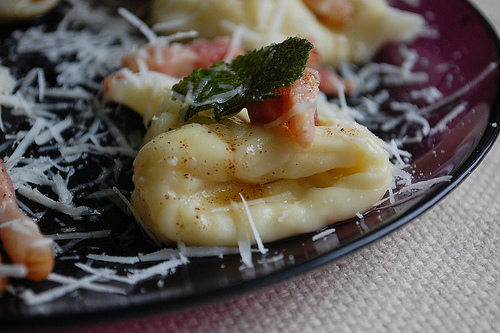

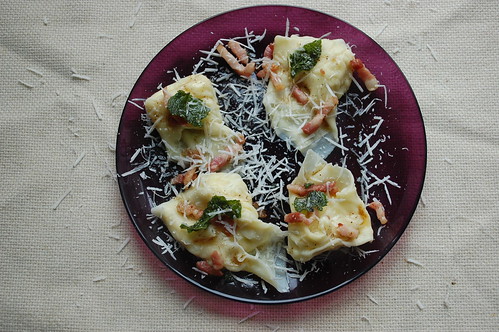

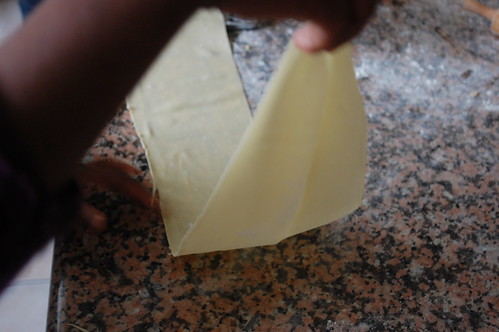
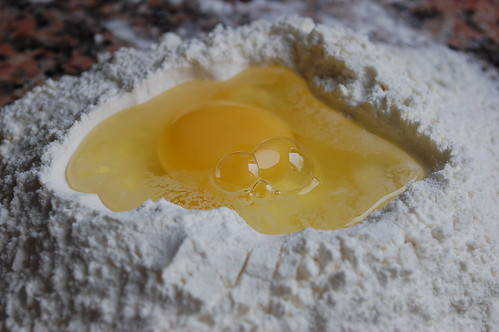
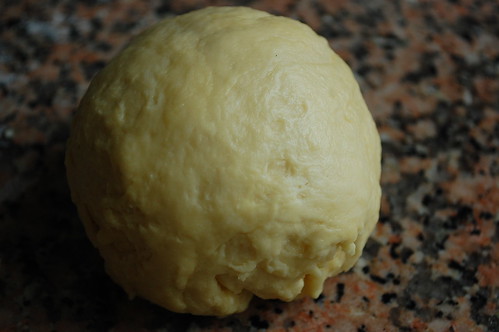
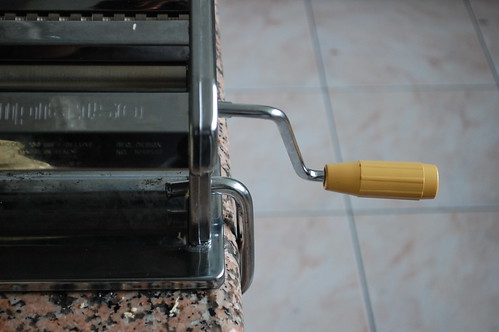
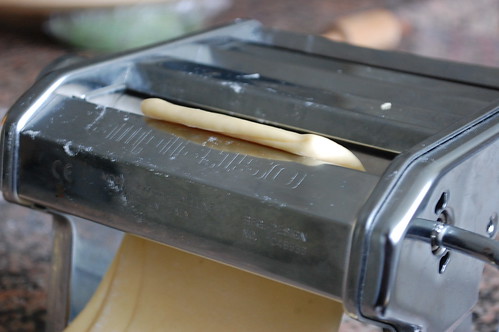
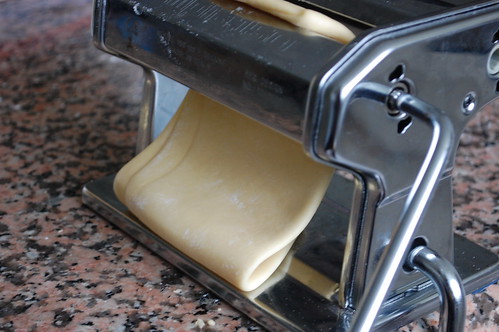
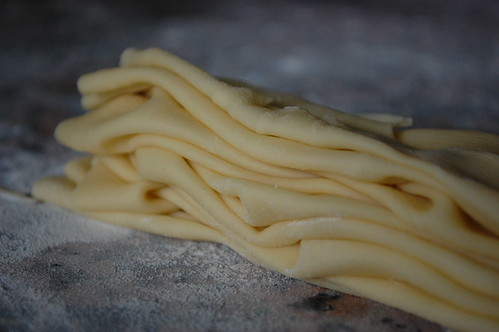
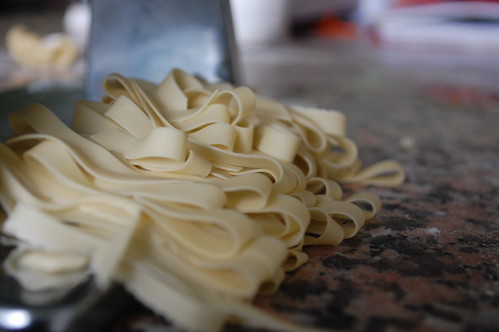

Leave a Reply